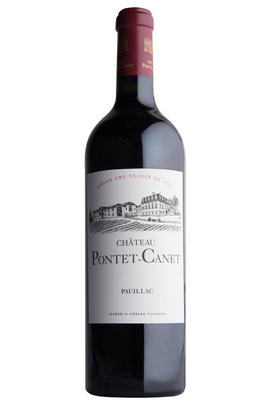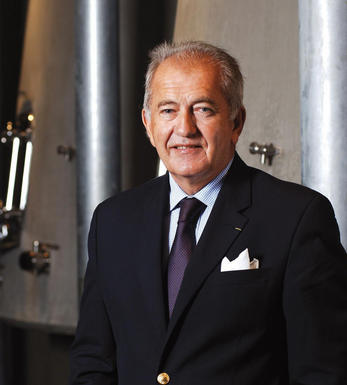
2012 Château Pontet-Canet, Pauillac, Bordeaux

Critics reviews
A wine of real class, pedigree and distinction, the 2012 Pontet-Canet is absolutely gorgeous. The flavours are beautifully nuanced and delineated throughout. Bright floral notes add lift and sensuality. The 2012 is decidedly understated next to some other recent vintages, but the magic of this site simply won't be denied. This is another sublime wine from proprietor Alfred Tesseron.
Drink 2018 - 2032
Antonio Galloni, Vinous.com (January 2016)
65% Cabernet Sauvignon, 30% Merlot, 4% Cabernet Franc and 1% Petit Verdot.
Deep purple-ruby. Perfumed nose of violet and ripe blackberry jam. Smooth, rich and almost sweet on entry, then increasingly austere, with the sweet cassis and delicate herbal flavours overshadowed by rising, raw tannins. I detected a slightly green quality on the long finish. Though this wine lacks the amazingly sweet flesh of the '09 and '10 wines and the classic elegance of the '08, I like its precision. Alfred Tesseron told me the estate picked late, on October 4, to offer the grapes a greater chance of reaching suitable ripeness, but they harvested quickly, using an extra sorting table.
Ian D'Agata, Vinous.com (May 2013)
Deep garnet in color, the 2012 Pontet-Canet gives up a profound earthy/savory nose, revealing notes of tilled soil, woodsmoke, mossy tree bark, fungi and bouquet garni with a core of raspberry preserves, boysenberries and dried cherries plus a hint of warm cassis. Medium-bodied, it has a firm grainy texture and a softly spoken, savory character in the mouth, finishing with lingering oolong tea and dried herbs notes.
Drink 2020 - 2041
Lisa Perrotti-Brown, Wine Advocate (May 2020)
A wine that makes you want to drink it already. It's stylish with berries, currants, cedar and stone aromas and flavours. Full body, with very integrated tannins and a long, long finish. A small percentage of the wine is now aged in cement vats instead of oak barrels. This touches all the senses. It's a beauty. Made from biodynamic grapes.
James Suckling, JamesSuckling.com (November 2013)
What an expressive nose! Plump, fruit-driven, juicy cherry, blackberry, ripe cassis and rose stem. The opposite of the 2011, this is round and suave, albeit with not quite as long a finish. A juicy, bright palate with high alcohol and full body, some oak-derived coffee tones, with burgeoning touches of earth. The first vintage with 35% ageing in concrete amphorae.
Drink 2021 - 2045
Panos Kakaviatos, Decanter.com (September 2021)
Fresh and lively aromatically, with spring flowers, sappy herbs, licorice, currant bud and earth, the 2012 is medium to full-bodied, tight, closed and focused, with fine, grippy tannin and a rock-solid finish. It lacks a touch of density and exuberance but is an elegant, lengthy 2012 that needs 3-4 years of cellaring and will keep through 2032.
Drink 2019 - 2032
Jeb Dunnuck, JebDunnuck.com (October 2018)
About this WINE

Chateau Pontet-Canet
Château Pontet-Canet is a large Pauillac estate that can trace its origins back to 1725, when Jean-François Pontet gave his name to the estate he had acquired. The wine was not château-bottled until 1972 and in 1975 the property was sold to Guy Tesseron, of the Tesseron family, one of the finest exponents of luxury, very old, aged Cognacs (Cognac Tesseron).
The Tesserons also own Château Lafon-Rochet in St-Estephe. Today, Château Pontet-Canet is owned and run by Alfred and Michel Tesseron.
Pontet-Canet's 78 hectares of vineyards adjoin those of Mouton Rothschild and are planted with Cabernet Sauvignon (63%), Merlot (32%) and Cabernet Franc (5%).
The Tesserons have vastly improved the quality of the Pontet-Canet wines which are now full-bodied and packed with ripe, chewy, black fruits and finely integrated tannins. The wines posseses marvellous ageing potential.
Pontet-Canet is classified as a 5ème Cru Classé.

Pauillac
Pauillac is the aristocrat of the Médoc boasting boasting 75 percent of the region’s First Growths and with Grand Cru Classés representing 84 percent of Pauillac's production.
For a small town, surrounded by so many familiar and regal names, Pauillac imparts a slightly seedy impression. There are no grand hotels or restaurants – with the honourable exception of the establishments owned by Jean-Michel Cazes – rather a small port and yacht harbour, and a dominant petrochemical plant.
Yet outside the town, , there is arguably the greatest concentration of fabulous vineyards throughout all Bordeaux, including three of the five First Growths. Bordering St Estèphe to the north and St Julien to the south, Pauillac has fine, deep gravel soils with important iron and marl deposits, and a subtle, softly-rolling landscape, cut by a series of small streams running into the Gironde. The vineyards are located on two gravel-rich plateaux, one to the northwest of the town of Pauillac and the other to the south, with the vines reaching a greater depth than anywhere else in the Médoc.
Pauillac's first growths each have their own unique characteristics; Lafite Rothschild, tucked in the northern part of Pauillac on the St Estèphe border, produces Pauillac's most aromatically complex and subtly-flavoured wine. Mouton Rothschild's vineyards lie on a well-drained gravel ridge and - with its high percentage of Cabernet Sauvignon - can produce (in its best years) Pauillac's most decadently rich, fleshy and exotic wine.
Latour, arguably Bordeaux's most consistent First Growth, is located in southern Pauillac next to St Julien. Its soil is gravel-rich with superb drainage, and Latour's vines penetrate as far as five metres into the soil. It produces perhaps the most long-lived wines of the Médoc.
Recommended Châteaux
Ch. Lafite-Rothschild, Ch. Latour, Ch. Mouton-Rothschild, Ch. Pichon-Longueville Baron, Ch. Pichon Longueville Comtesse de Lalande, Ch. Lynch-Bages, Ch. Grand-Puy-Lacoste, Ch, Pontet-Canet, Les Forts de Latour, Ch. Haut-Batailley, Ch. Batailley, Ch. Haut-Bages Libéral.

Cabernet Sauvignon Blend
Cabernet Sauvignon lends itself particularly well in blends with Merlot. This is actually the archetypal Bordeaux blend, though in different proportions in the sub-regions and sometimes topped up with Cabernet Franc, Malbec, and Petit Verdot.
In the Médoc and Graves the percentage of Cabernet Sauvignon in the blend can range from 95% (Mouton-Rothschild) to as low as 40%. It is particularly suited to the dry, warm, free- draining, gravel-rich soils and is responsible for the redolent cassis characteristics as well as the depth of colour, tannic structure and pronounced acidity of Médoc wines. However 100% Cabernet Sauvignon wines can be slightly hollow-tasting in the middle palate and Merlot with its generous, fleshy fruit flavours acts as a perfect foil by filling in this cavity.
In St-Emilion and Pomerol, the blends are Merlot dominated as Cabernet Sauvignon can struggle to ripen there - when it is included, it adds structure and body to the wine. Sassicaia is the most famous Bordeaux blend in Italy and has spawned many imitations, whereby the blend is now firmly established in the New World and particularly in California and Australia.


Buying options
Add to wishlist
Description
What an expressive nose! Plump, fruit-driven, juicy cherry, blackberry, ripe cassis and rose stem. The opposite of the 2011, this is round and suave, albeit with not quite as long a finish. A juicy, bright palate with high alcohol and full body, some oak-derived coffee tones, with burgeoning touches of earth. The first vintage with 35% ageing in concrete amphorae.
Drink 2021 - 2045
Panos Kakaviatos, Decanter.com (September 2021)
wine at a glance
Delivery and quality guarantee